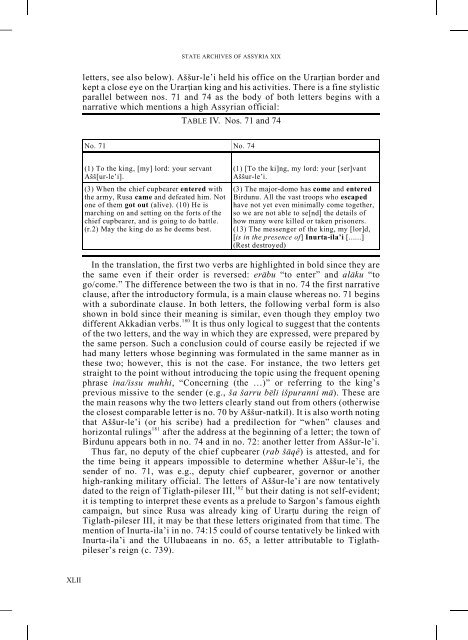Download PDF version of SAA 19 introduction - UCL
Download PDF version of SAA 19 introduction - UCL
Download PDF version of SAA 19 introduction - UCL
Create successful ePaper yourself
Turn your PDF publications into a flip-book with our unique Google optimized e-Paper software.
STATE ARCHIVES OF ASSYRIA XIX<br />
letters, see also below). Aššur-le’i held his <strong>of</strong>fice on the Urarṭian border and<br />
kept a close eye on the Urarṭian king and his activities. There is a fine stylistic<br />
parallel between nos. 71 and 74 as the body <strong>of</strong> both letters begins with a<br />
narrative which mentions a high Assyrian <strong>of</strong>ficial:<br />
TABLE IV. Nos. 71 and 74<br />
No. 71 No. 74<br />
(1) To the king, [my] lord: your servant<br />
Ašš[ur-le’i].<br />
(3) When the chief cupbearer entered with<br />
the army, Rusa came and defeated him. Not<br />
one <strong>of</strong> them got out (alive). (10) He is<br />
marching on and setting on the forts <strong>of</strong> the<br />
chief cupbearer, and is going to do battle.<br />
(r.2) May the king do as he deems best.<br />
(1) [To the ki]ng, my lord: your [ser]vant<br />
Aššur-le’i.<br />
(3) The major-domo has come and entered<br />
Birdunu. All the vast troops who escaped<br />
have not yet even minimally come together,<br />
so we are not able to se[nd] the details <strong>of</strong><br />
how many were killed or taken prisoners.<br />
(13) The messenger <strong>of</strong> the king, my [lor]d,<br />
[is in the presence <strong>of</strong>] Inurta-ila’i [......]<br />
(Rest destroyed)<br />
In the translation, the first two verbs are highlighted in bold since they are<br />
the same even if their order is reversed: era − bu “to enter” and ala − ku “to<br />
go/come.” The difference between the two is that in no. 74 the first narrative<br />
clause, after the introductory formula, is a main clause whereas no. 71 begins<br />
with a subordinate clause. In both letters, the following verbal form is also<br />
shown in bold since their meaning is similar, even though they employ two<br />
different Akkadian verbs. 180 It is thus only logical to suggest that the contents<br />
<strong>of</strong> the two letters, and the way in which they are expressed, were prepared by<br />
the same person. Such a conclusion could <strong>of</strong> course easily be rejected if we<br />
had many letters whose beginning was formulated in the same manner as in<br />
these two; however, this is not the case. For instance, the two letters get<br />
straight to the point without introducing the topic using the frequent opening<br />
phrase ina/issu muhhi, “Concerning (the …)” or referring to the king’s<br />
previous missive to the sender (e.g., ša šarru be − l l −<br />
išpuranni ma − ). These are<br />
the main reasons why the two letters clearly stand out from others (otherwise<br />
the closest comparable letter is no. 70 by Aššur-natkil). It is also worth noting<br />
that Aššur-le’i (or his scribe) had a predilection for “when” clauses and<br />
horizontal rulings 181 after the address at the beginning <strong>of</strong> a letter; the town <strong>of</strong><br />
Birdunu appears both in no. 74 and in no. 72: another letter from Aššur-le’i.<br />
Thus far, no deputy <strong>of</strong> the chief cupbearer (rab ša − qê) is attested, and for<br />
the time being it appears impossible to determine whether Aššur-le’i, the<br />
sender <strong>of</strong> no. 71, was e.g., deputy chief cupbearer, governor or another<br />
high-ranking military <strong>of</strong>ficial. The letters <strong>of</strong> Aššur-le’i are now tentatively<br />
dated to the reign <strong>of</strong> Tiglath-pileser III, 182 but their dating is not self-evident;<br />
it is tempting to interpret these events as a prelude to Sargon’s famous eighth<br />
campaign, but since Rusa was already king <strong>of</strong> Urarṭu during the reign <strong>of</strong><br />
Tiglath-pileser III, it may be that these letters originated from that time. The<br />
mention <strong>of</strong> Inurta-ila’i in no. 74:15 could <strong>of</strong> course tentatively be linked with<br />
Inurta-ila’i and the Ullubaeans in no. 65, a letter attributable to Tiglathpileser’s<br />
reign (c. 739).<br />
XLII

















